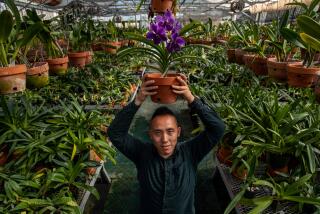The Aristocratic Orchid Casts a Spell of Beauty and Elegance
The orchid, with its delightful fragrance, rare beauty and flamboyant appeal, is the aristocrat of all flowers.
But the impression that orchids are difficult to grow and that all orchids require greenhouse conditions is not true. They are no more difficult to tend than indoor house plants or outdoor gardens.
Throughout the world--from the hot coastal region of the tropics to the chilly mountains of the Himalayas--orchids are found.
In the wild, orchids grow in swamps, on rocks, in trees, in bogs along wet meadows, in shaded wooded areas and even underground.
The best way to learn about orchids is to attend an orchid club meeting or one of the Southland’s orchid shows. But before you do that, let’s take a look at the fascinating history of this plant.
The orchid, whose name is derived from the Greek word orchis, was used by early herbalists as an aphrodisiac and contraceptive.
In Asia, people were infatuated with the elegant and delightful orchid fragrance. The Chinese Emperor Sheng Nung in 2800 BC advised using the dendrobium orchid for medicinal purposes.
In one of the most revered books of China, the “I-Ching” (Book of Change), the orchid is referred to as the “King of the Fragrant Plants.” The Chinese word for orchid is Lan and in the I-Ching Confucius wrote these lines: “The words by friends with one and the same heart are just as sweet as the aroma of the Lan.”
In ancient Japan, where the orchid was called Ran, the first book on the plant is believed to have been written by Mat-su-oka. In it, he gave his famous four steps for cultivation of the cymbidium orchid:
In spring don’t put them out of doors.
In summer don’t expose them to too much sun.
In autumn don’t keep them too dry.
In winter don’t keep them too wet.
This simple philosophy has kept the cymbidium orchid, with its graceful foliage and lovely flowers, a vibrant and flourishing favorite of Oriental art.
When the Spanish conqueror Cortez arrived in Mexico about 1519, he was served a perfumed drink and thus was introduced to the vanilla orchid plant by the Aztecs. On Cortez’s return trip to Europe, he took cuttings of this orchid plant whose beans had been used in the drink. The flavoring became very popular, and today we know it as vanilla.
One of the most common fragrant orchids is the cattleya, also referred to as the “Queen of the Orchids.” Originally from Brazil, the cattleya was accidentally discovered in a shipment to England in 1818 by William Cattley. In 1824, Cattley successfully bloomed the orchid for the first time in captivity.
The cattleya is epiphytic. In other words, it is found in the wild growing off the sides of trees, rooted in the bark. Thus, orchid growers find that the growing medium for these fragrant blooming plants is bark, not dirt.
From about the 17th Century on, orchids of every nature were discovered, exported and cultivated. Some orchids never survived because of crude transportation methods. Many ended up on the ocean floor, destroyed by vicious storms or shipboard fires. The number of species that has vanished from the face of the Earth is unknown.
As far as we are aware, the orchid family contains the largest number of flowering plants known: some 35,000 wild species, many of which are becoming extinct. This, of course, does not include thousands of hybrid orchids, which are the result of growers who have mated or crossed orchid plants.
Some of the flowering beauties:
* The “moth orchid,” more properly known as Phalaenopsis , got its name from two Greek words-- phaluna meaning “moth” and opsis meaning “resembling.”
The moth orchid, which originated in Southeast Asia, can successfully be grown at home. It thrives in a minimum night temperature of 62 degrees. It can tolerate heat better than most orchids and will withstand 90-degree temperatures, as long as air circulation and humidity are adequate.
* The Odontoglossum tribe is one of the more fascinating of the orchid family. These unique flowers have fanciful names, such as “Pansy,” “Spider” and “Dancing Ladies.” They include the genera of Miltonia, Brassia and Oncidium.
Their homes range from Costa Rica to Colombia and Brazil for Miltonias, Mexico to Brazil and Peru for Brassia, Mexico through Central and South America for Oncidium , and, finally, the foggy regions high in the Andes Mountains of South America for Odontoglossum itself.
* Paphiopedilum, or “Lady Slipper,” is a member of the Cypripedium tribe. It is by far the most primitive evolutionary group in the vast family of orchids. These flowers appear more artificial than real, with striking, often bizarre color combinations and seemingly waxed and lacquered textures.
* Paphiopedilum does not require high-intensity light; therefore, it is ideal for windows with filtered light. The “Lady Slipper” requires moisture and will hold its bloom for two months or longer.
Under the flag of the American Orchid Society, hundreds of small community orchid societies exist across the country. The purpose of these societies is the preservation of orchids by sharing the experience of growing these most elegant plants.






